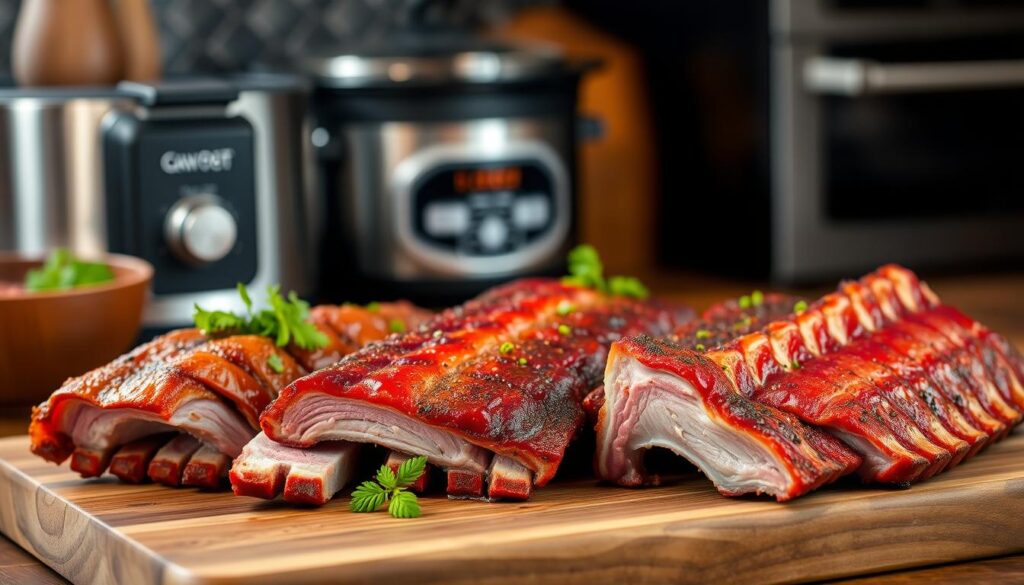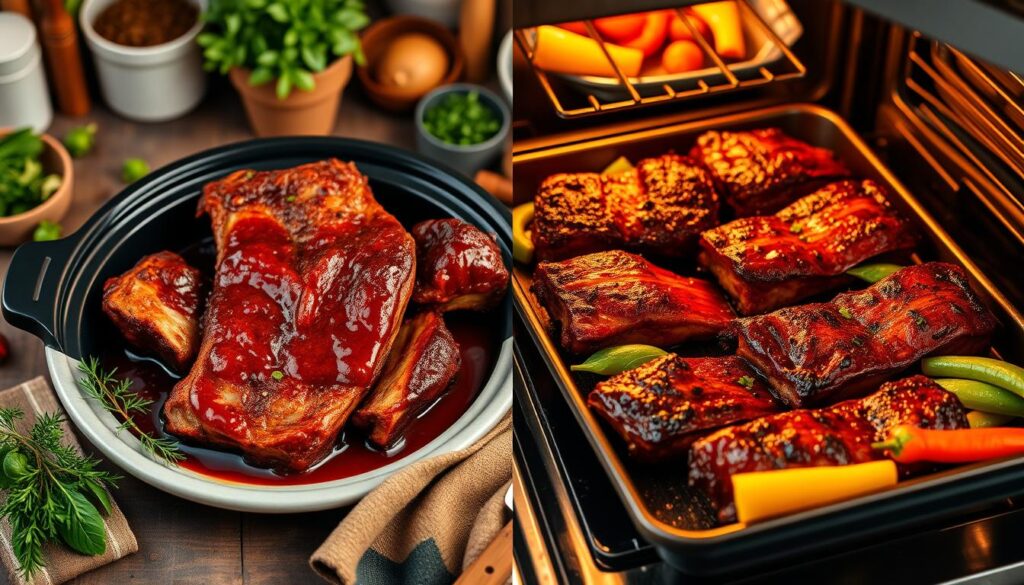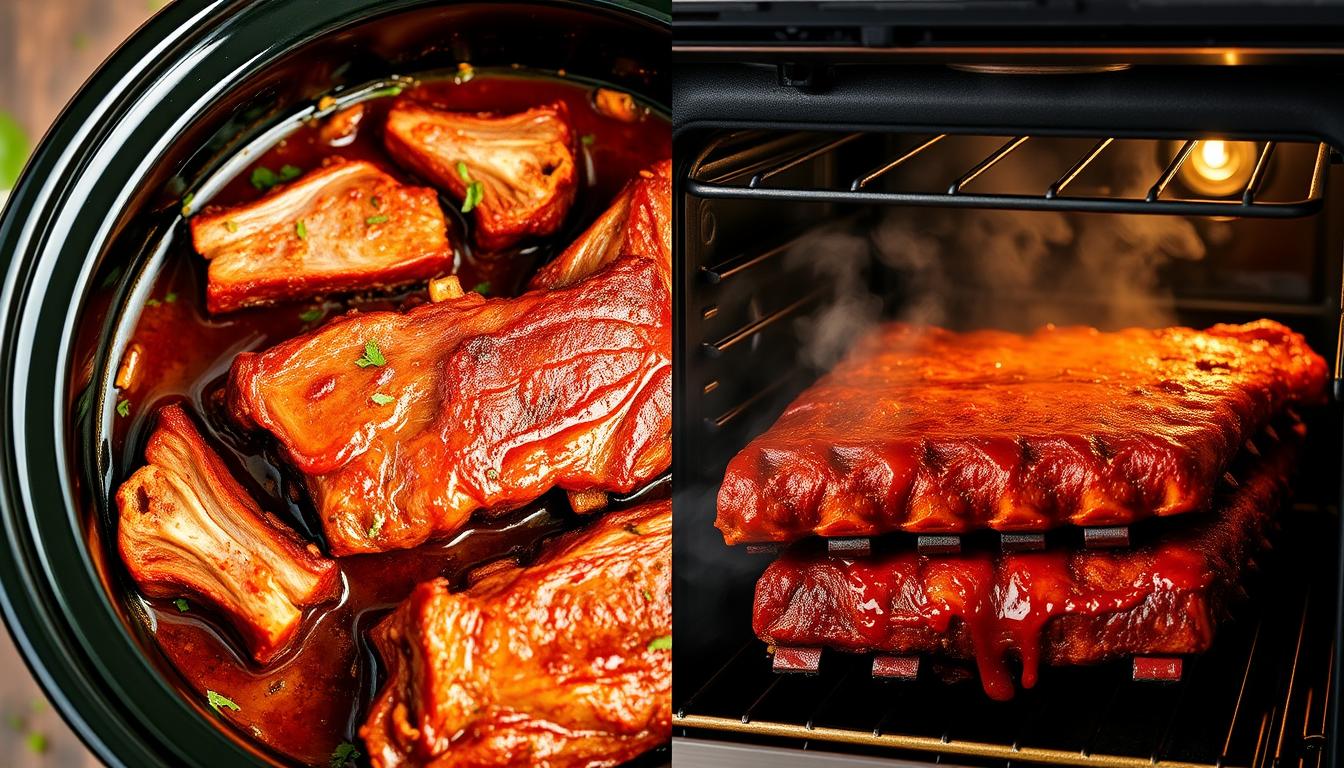The smell of perfectly cooked barbecue ribs can make any meal special. As a home cook, I’ve tried many slow cooking methods. I want to find out how to make ribs that are so tender, they fall off the bone.
Is it better to cook ribs in a crockpot or oven? This debate has many fans on both sides. Baby back ribs are small, with a delicate taste that needs careful cooking. Whether you’re a beginner or an expert, knowing how to slow cook ribs can improve your barbecue skills.
Getting tender, flavorful ribs is more than just using heat. It’s about the technique, patience, and understanding the meat’s transformation. We’ll look at the good and bad of crockpot and oven cooking. This will help you find the best way to cook ribs for your next barbecue.
Understanding Different Types of Ribs for Perfect Cooking
Choosing the right ribs is key to a great oven-baked ribs experience. Each rib type has its own traits that affect your cooking and the taste of your dish.

It’s important to know the differences between rib types. This helps you pick the best cut for your cooking method. Let’s dive into the world of ribs and their special qualities.
Baby Back Ribs vs Spare Ribs
Baby back ribs are shorter and more tender, usually 3 to 6 inches long. They have:
- More uniform shape
- Less connective tissue
- Typically more expensive
- About 8 ribs per rack
Spare ribs, on the other hand, are bigger and more affordable. They offer:
- Approximately 13 ribs per rack
- More meat per rack
- Higher fat content
- Lower price point
Choosing the Right Cut for Each Cooking Method
Your cooking method is important when picking ribs. For oven-baked ribs, here’s what to keep in mind:
- Baby back ribs are best for quick cooking
- Spare ribs are great for slow cooking
- Cook at a temperature of 165-170 degrees Celsius
Meat Quality and Selection Tips
When picking ribs, focus on these important factors:
- Marbling: Look for even fat distribution
- Fresh meat with little discoloration
- Marinate for 6-8 hours
- Check for even meat thickness
Pro tip: Fresh spices and the right meat choice are essential for amazing oven-baked ribs. They’ll surely impress your guests.
Are ribs better in the crockpot or oven?

Choosing between a crockpot and an oven for ribs is not easy. Each method has its own benefits. The crockpot is great for slow cooking, making tough meat tender and delicious.
Let’s look at the main points of the crockpot vs oven debate:
- Crockpot Advantages:
- Consistent low temperature (7-9 hours on LOW setting)
- Minimal supervision required
- Exceptional meat tenderness
- Oven Advantages:
- Better caramelization and crust development
- More precise temperature control
- Faster cooking times
Your choice depends on your schedule and the texture you want. For tender ribs, the crockpot is perfect. For a crispy exterior, the oven is better.
Many chefs suggest using both methods. Start with the crockpot for tenderness, then finish in the oven for a crispy crust.
Essential Preparation Techniques for Both Methods
Preparing ribs is an art that needs careful attention. Mastering meat preparation techniques will help you make tender ribs. The secret to success is in the preparation before cooking.
Before cooking, there are key steps to make your ribs delicious. Let’s explore the essential preparation methods to improve your rib game.
Membrane Removal and Trimming
Removing the thin membrane from the back of the ribs is key for maximum flavor absorption. Use a knife to lift the membrane at one end, then pull it off completely. Trimming excess fat makes the cooking surface even.
- Use a paper towel for better grip when removing membrane
- Trim visible large fat deposits
- Ensure even thickness across the rack
Dry Rub Application Tips
Creating a perfect dry rub is vital for deep flavors in your ribs. Pat the ribs dry before applying the rub to help it stick better. Massage the seasoning generously, covering every surface.
- Mix your favorite spices
- Apply rub evenly
- Let ribs sit for 15 minutes at room temperature
Marination Techniques
Marinating can make your ribs amazing. While not always needed, a quick marinade adds flavor and tenderizes the meat. Aim for 2-12 hours for the best results.
Pro tip: Avoid marinating for too long, as acidic marinades can break down the meat’s texture.
Crockpot Ribs: Time and Temperature Guide
Slow cooking ribs in a crockpot makes them incredibly juicy. It’s all about the right temperature and cooking time. This way, you get those tender ribs everyone loves.
For the best slow cooking results, follow these tips:
- Set your crockpot to LOW heat for optimal moisture retention
- Plan for 5-7 hours of cooking time
- Avoid using HIGH setting to prevent dry, tough meat
Getting your ribs ready needs some planning. Check your crockpot’s specific instructions before starting. The USDA says to thaw meat fully before slow cooking for safety and even cooking.
Your choice of liquid is key for juicy ribs. Consider using:
- Beef broth for rich flavor
- Beer for tenderizing
- Apple juice for subtle sweetness
Pro tip: Use only about 1/2 cup of liquid to avoid soggy ribs. The meat will release its own moisture during cooking.
With careful preparation, you can make restaurant-quality ribs at home. They’ll be tender, flavorful, and sure to impress!
Mastering Oven-Baked Ribs: Temperature Control and Timing
Getting perfect oven-baked ribs needs precision and knowing how to compare cooking methods. Your journey to tasty ribs begins with mastering temperature control and timing.
To make oven-baked ribs tender and flavorful, aim for a temperature of 275°F to 300°F. This range ensures slow, even cooking.
Direct vs Indirect Heat Methods
Choosing the right heat method can change your rib-cooking game. Here are the main approaches:
- Direct heat: Sears the outside, making it crispy
- Indirect heat: Cooks slowly for tender meat
- Combination method: Uses indirect heat first, then direct for perfect caramelization
Wrapping Techniques
Wrapping is key for keeping ribs moist. Aluminum foil keeps juices in and prevents drying. Try different wrapping methods to find your favorite.
Basting Strategies
Basting keeps ribs moist and adds flavor. Here are some tips:
- Brush sauce every 30 minutes during cooking
- Use a mix of dry rub and liquid marinade
- Apply a final glaze during the last 15 minutes of cooking
Cooking times usually range from 2-3 hours. Patience and careful watching are key to making delicious oven-baked ribs that will wow any barbecue fan.
Flavor Profiles and Seasoning Approaches
Creating juicy ribs begins with understanding flavor profiles. These profiles turn simple meat into a culinary masterpiece. Your seasoning approach is key to a great barbecue experience. Different regions in the United States offer unique tastes that can make your ribs stand out.
When exploring seasoning techniques, consider these key flavor categories:
- Sweet and Tangy: Kansas City-style rubs with brown sugar and molasses
- Spicy and Bold: Memphis dry rub featuring paprika and cayenne pepper
- Smoky and Complex: Texas-inspired blends with robust spice combinations
For truly memorable juicy ribs, focus on these seasoning strategies:
- Apply dry rubs 2-24 hours before cooking
- Layer flavors with complementary marinades
- Consider spice intensity based on cooking method
Professional pitmasters suggest making your own rubs. They balance salt, sugar, and spices. Whether you like sweet glazes or spicy flavors, the right seasoning makes your meal unforgettable.
The Science Behind Tender Ribs: Low and Slow vs Hot and Fast
Making tender ribs is more than just cooking. It’s a science that changes the meat’s texture. Your choice of cooking method, whether low and slow or hot and fast, greatly affects the ribs’ taste.
Breaking Down Connective Tissues
Meat science is key to making perfectly tender ribs. Connective tissues need certain temperatures to break down well. Cooking at low temperatures, between 225°F and 275°F, helps collagen turn into gelatin.
Moisture Retention Techniques
To keep ribs juicy, use certain cooking methods. Here are some tips:
- Wrap ribs in foil during cooking
- Spritz with apple juice every 30-45 minutes
- Maintain consistent low temperatures
- Allow a 10-15 minute resting period after cooking
Temperature’s Impact on Meat Texture
Different temperatures lead to different textures in ribs. Low and slow cooking makes ribs tender, while hot and fast methods make them firmer. The best internal temperature for tenderness is between 195°F and 205°F.
By grasping these scientific principles, you can turn regular ribs into a memorable dish.
Sauce Application and Glazing Techniques
Mastering sauce application can take your barbecue ribs from great to amazing. Timing and technique are key for that perfect glaze. It’s what makes your ribs irresistible.
For the best ribs, apply sauce last. Wait until the ribs have cooked for 30-45 minutes. This avoids burning and gives a sweet, sticky glaze. It brings out the meat’s natural taste.
- Apply glaze every 10-15 minutes during final cooking stage
- Use a thick, sugar-based glaze for better adhesion
- Maintain oven temperature around 400°F for optimal glazing
Homemade glazes can be a mix of ingredients for depth and shine. A classic glaze might include:
- Brown sugar for sweetness
- Honey for smooth texture
- Apple cider vinegar for tanginess
- Selected spices to complement barbecue ribs
Experts say to use about 1/2 cup of glaze for a rack of ribs. Thin layers are better than one thick coat. You want a glossy finish that keeps moisture and flavor in.
Common Mistakes to Avoid in Both Cooking Methods
Mastering meat preparation techniques for rib recipes is key. Knowing common mistakes helps avoid disappointment. Whether using a crockpot or oven, several errors can ruin your ribs.
- Liquid Management: Over 60% of home cooks add too much liquid. The right amount should cover only ¼ to ⅓ of the rib thickness.
- Temperature Control: Wrong temperatures can make meat tough or dry. Slow cookers work between 160°F to 280°F, so watch the temperature closely.
- Searing Shortcuts: Skipping the searing step reduces flavor. This is because it misses the Maillard reactions.
Cooking ribs needs patience and precision. Avoid boiling ribs to prevent tough meat. Instead, keep the simmer steady to break down tissues well.
In a slow cooker, opening the lid adds 30 minutes to cooking. Fill it halfway to three-quarters full for even cooking. For oven cooking, wrap ribs to keep moisture in and prevent drying.
- Never use frozen meat in a slow cooker
- Add fresh herbs only in the last 30 minutes of cooking
- Layer root vegetables at the bottom for proper softening
By knowing these key techniques, you’ll improve your meat preparation. This ensures tender, flavorful ribs every time.
Conclusion
Choosing between the crockpot and oven for ribs depends on your cooking style and how much time you have. Both methods can make delicious ribs if you pay attention to the details.
Success with ribs means knowing the differences between cooking methods. The crockpot makes ribs tender, taking 6 to 8 hours for 4 lbs of beef short ribs. On the other hand, the oven lets you control how crispy the outside gets.
Try different ways to cook ribs to find what works best for you. Whether it’s the crockpot’s sealed moisture or the oven’s precise heat, the key is preparation, seasoning, and patience. Don’t hesitate to try both and see which one you like better.
Great ribs come from skill, not just the tools you use. With practice, you’ll learn to make ribs that everyone will love, no matter if you use a crockpot or oven.
FAQ
Are ribs better in the crockpot or oven?
Both ways can make delicious ribs. The crockpot cooks ribs slowly, making them tender. The oven lets you control the temperature and get a crispy outside. It’s up to you, based on what you like and how much time you have.
How long does it take to cook ribs in a crockpot?
Ribs in a crockpot take 6-8 hours on low or 3-4 hours on high. This slow cooking makes the meat tender and easy to pull off the bone.
What temperature should I use when cooking ribs in the oven?
Cook ribs in the oven at 275°F (135°C) for 2-3 hours. This keeps the meat moist. Then, raise the temperature to 350°F (175°C) for 15-20 minutes to crisp the outside.
Do I need to remove the membrane from ribs?
Yes, remove the membrane for better flavor and tenderness. Use a knife to start and a paper towel to pull it off.
Can I use the same seasoning for crockpot and oven-baked ribs?
Yes, you can use the same seasonings for both. But, adjust the dry rub for crockpot cooking. Oven cooking lets you apply seasonings directly and caramelize them better.
How do I know when ribs are fully cooked?
Check the internal temperature, which should be 145°F (63°C). Also, look for meat that pulls away easily from the bone. Crockpot ribs should be soft, while oven ribs should have a slight resistance.
What’s the best way to add barbecue sauce to ribs?
Add barbecue sauce in the last 15-30 minutes of cooking. This prevents burning and helps the sauce caramelize. For crockpot ribs, add sauce and switch to high heat to set the glaze.
Can I prepare ribs in advance?
Yes, you can prepare ribs ahead of time. Apply the dry rub and refrigerate overnight or cook partially and finish later. For crockpot ribs, reheat gently. Oven ribs can be partially cooked and finished just before serving.

